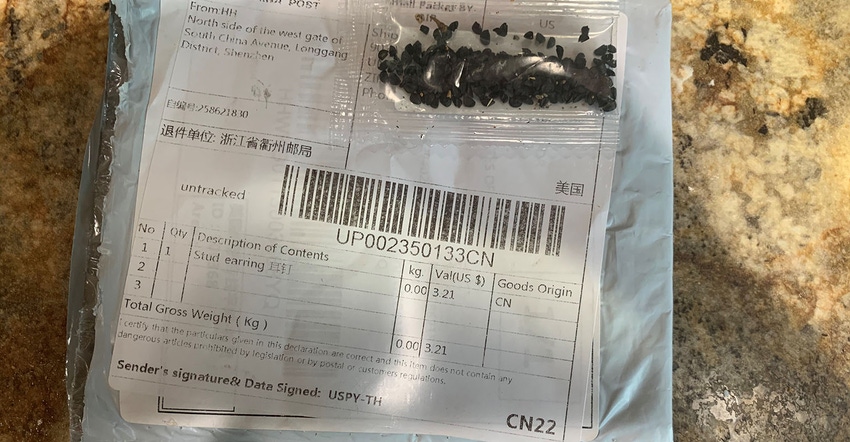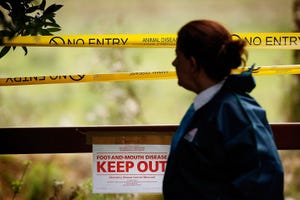Mystery seed identification begins
USDA identifies seeds as vegetables, herbs, ornamentals, fruits and weeds; recipients urged to mail to authorities.
August 6, 2020

An Arkansas man who planted the "mystery seeds" he received in the mail said the plant is producing large white fruit from orange flowers that resemble those of a squash, according to the New York Post.
"Every two weeks, I'd come by and put Miracle-Gro on it, and they just started growing like crazy," Booneville, Arkansas, resident Doyle Crenshawn told KSFM.
U.S. residents in all 50 states have reported getting the packages. Residents in Canada, Australia and European Union nations have also received the mystery seed packets, which are sometimes identified as jewelry.
Don't plant the seeds
USDA's Animal and Plant Health Inspection Service is working with the Department of Homeland Security's Customs and Border Protection, other federal agencies and state agriculture departments to investigate. USDA has compiled a list of mailing addresses for the seeds and offers these instructions:
Save the seeds and the package they came in, including the mailing label.
Do not open the seed packets.
Do not plant any of the seed.
If the packets are already open, place all materials (seeds and packaging) into a zip lock bag and seal it.
Place everything (seeds and any packaging, including the mailing label) in a mailing envelope. Please include your name, address, and phone number so that a State or Federal agriculture official can contact you for additional information.
If you can't mail the seeds, call your state plant regulatory officials or APHIS state plant health director to arrange a no-contact pick up or determine a convenient drop-off location.
What if I already planted the seeds?
If you already planted the seeds:
Remove the seeds or plants and at least 3 inches of the surrounding soil and place inside a plastic bag.
Squeeze out the air and tightly seal the bag.
Place the bag inside a second plastic bag, squeeze out the air and seal it tightly.
Put the bag in the municipal trash. Do not compost it.
If you planted the seeds in reusable pots or containers, wash the planting container with soap and water to remove any remaining dirt. It’s important to wash the container over a sink or other container to catch the run-off. Put the run-off down the drain or flush down a toilet.
Soak clean planting container in a 10 percent bleach and water solution for 30 minutes.
Have the seeds been identified?
The seeds USDA has identified include a mixture of ornamental, fruit, vegetable, herb and weed seeds. The seeds include mustard, cabbage, morning glory, mint, sage, rosemary, lavender, hibiscus and roses, according to Deputy Administrator Osama El-Lissy of USDA's Animal and Plant Health Inspection Service.
Why can't the seeds be tossed or planted?
Laura Meyerson, an invasion biologist at the University of Rhode Island, told Scientific American that since USDA doesn't know what the seeds are, they don't know if they'll be harmful. If planted, the plants could spread and become invasive. If tossed and germinated, they could spread. If released into the environment, there could be a sharing of genetic material.
Is there a connection to agro-terrorism?
At this point, USDA has not identified a link to agro-terrorism. The agency cautions that the situation is evolving and they continue to evaluate.
Where can I learn more?
USDA's Animal and Plant Health Inspective Service is keeping people up-to-date here.
Illinois Extension horticulture Educator Richard Hentschel has been an expert guest on national media outlets helping residents understand the danger of planting unknown seeds. Listen to his interview on WGN Radio. #mysteryseeds https://t.co/z1c06pq2jn
— Illinois Extension (@ILextension) August 5, 2020
Unknown seed packets from China arriving at your door? We talked to the Seed Administrator from @IndianaChemist to find out what should be done if these #MysterySeeds end up in your mailbox. #PurdueUniversity #BoilerUp #ScienceFromHome @INeLearn https://t.co/FjfrNzEZD4
— Superheroes of Science (@PurdueSOS) August 3, 2020
About the Author(s)
You May Also Like


.png?width=300&auto=webp&quality=80&disable=upscale)
